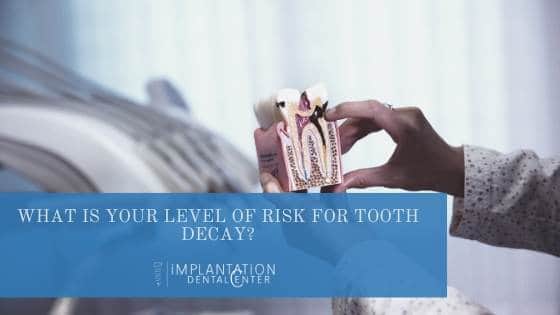Tooth decay can happen to anyone, but some people are at an increased risk. This can be due to health conditions, age, genetics, and a number of other reasons.
Tooth decay is simply damage to a tooth’s enamel and later dentin. This occurs when acid created by bacteria in your mouth damages a tooth’s surface. This bacteria can soften the tooth’s enamel and cause cavities to form. Without proper treatment, this can lead to tooth loss or infection.
Unfortunately, tooth decay has very few or no symptoms early on. But later, it can cause sensitivity to temperature and certain foods, as well as toothaches. Then, if it becomes infected it can even develop an abscess, which can cause facial swelling, fever, and discomfort or pain.
Causes of Tooth Decay
Tooth decay is caused by the combination of bacteria in your mouth and food and drinks that you consume each day. Plaque forms on your teeth when you eat and drink which contains the bacteria that damages your teeth.
By forming an acid that destroys tooth enamel, the bacteria continues to damage your teeth throughout each day. Your diet is a key part of keeping your teeth health. When you eat foods and consume drinks high in sugar, your risk of developing tooth decay increases.
Risk Factors for Tooth Decay
While you can’t control all factors that contribute to tooth decay such as asthma and other respiratory conditions that dry out your mouth, certain medications, and age, you can control others.
One of the best ways to reduce your risk of tooth decay is to practice good oral hygiene. Regular dental cleanings, using a fluoride toothpaste, limiting your intake of sugar and alcohol, and avoiding smoking can help.
This problem isn’t limited to adults. Children, toddlers, and infants are all at risk of developing tooth decay. As their new teeth form they are not stable enough to completely protect against bacteria.
Older adults also experience tooth decay and other cavities when their gums recede with age.
Prevention and Diagnosis
While you can’t prevent all forms of tooth decay, it’s important to try to keep your mouth and teeth as healthy as possible.
By brushing your teeth with the right toothpaste, flossing, and using mouthwash, you can be on your way to a healthier mouth. You also need to keep up with your regular dental cleanings. During these visits, your dental professionals can remove all of the plaque from your teeth that you can’t remove at home. They can also spot early signs of damage and cavities to help manage the issue before the teeth begin decaying.
Your diet has a big impact on your dental health as well. You should avoid foods and drinks high in sugar as often as possible. Also, limiting your alcohol intake can help protect your teeth.
Eating raw vegetables can help remove plaque from your teeth. You should also consume milk and other dairy products that contain calcium. This can help strengthen your teeth and fight off bacteria developing there. Gum also helps to remove food particles and keep your teeth clean for longer.
In addition to that, you can have your dentist put dental sealants on your child’s teeth. These are painted on to the molars and prevent cavities and also make the teeth easier to clean.
Typically, tooth decay is diagnosed by your dentist when they notice white spots, dark spots, or even holes in the teeth. They can also monitor tooth sensitivity and use x-rays to find tooth decay.
If you’re concerned about tooth decay, schedule an appointment today. We’ll walk you through the steps you should take to protect your teeth and we can also help diagnose and treat tooth decay.




Pingback: Dental inlays, onlays, and crowns - Implantation Dental Center